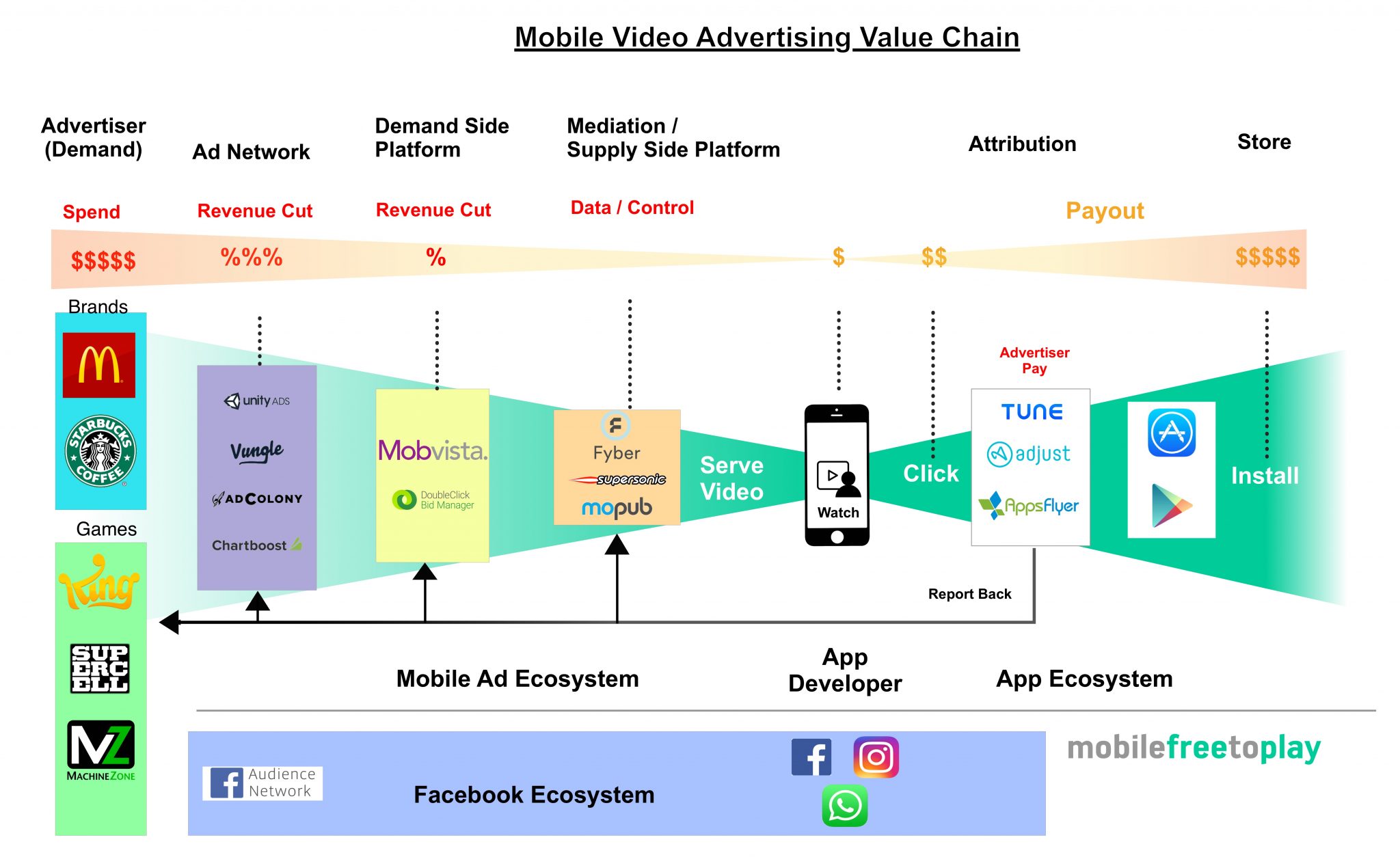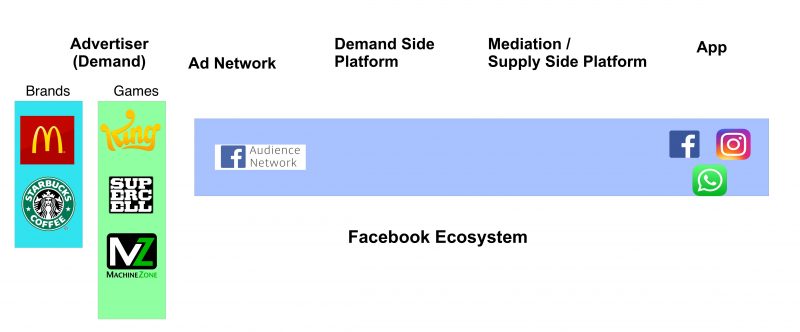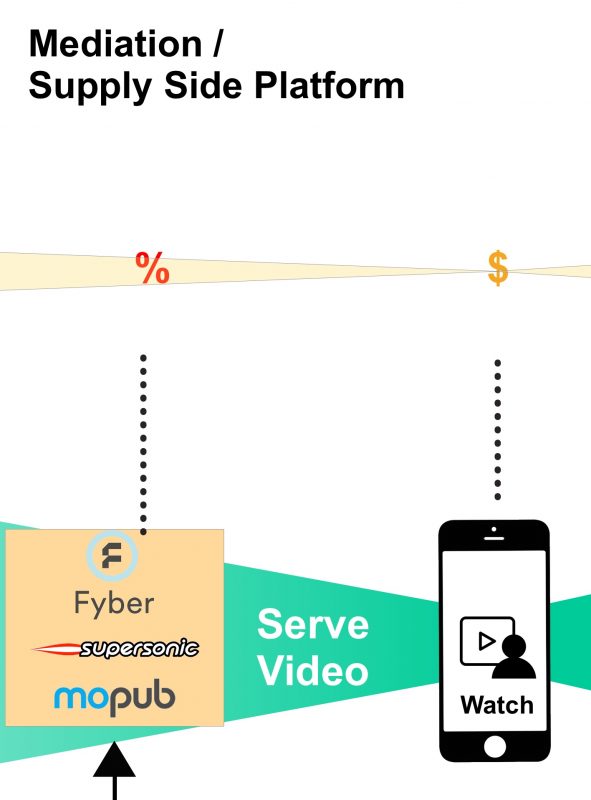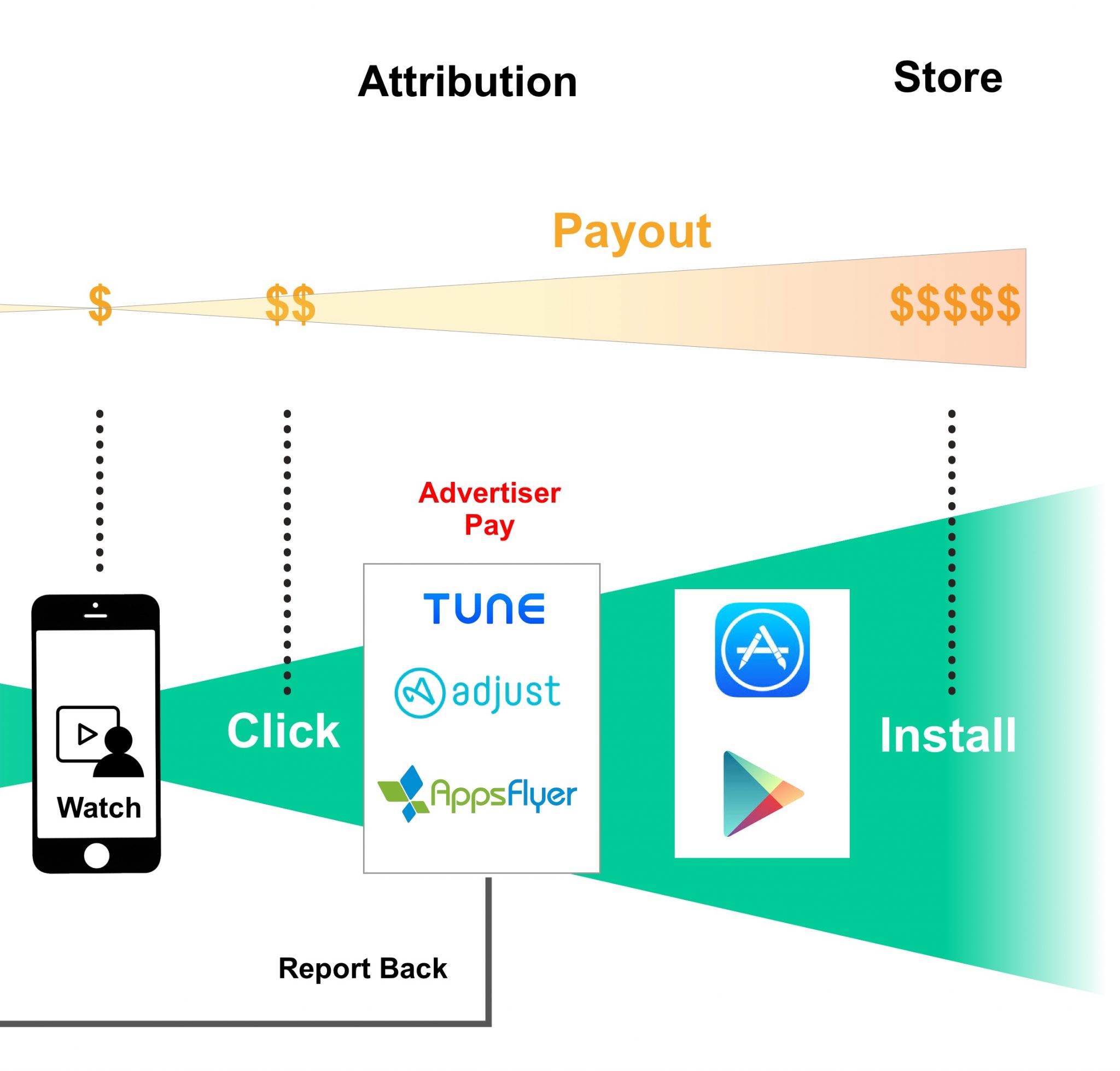Understanding the value chain for Mobile Video Ads
Video ad revenue now accounts for a large proportion of most casual free to play mobile games. Companies like Hipster Whale, Futureplay and the publisher Ketchapp have built business models focussed on rewarded video ads. This shows many of the similarities of the shift from premium to freemium. As an indie developer it’s relatively simple to drop a video ad into your game, but do you understand where the money comes from? In this piece we breakdown how the flow of money gets from the advertiser to your bank account.
Disclaimer: I have no affiliation and do not work for any of the partners mentioned, this guide is meant as a reference to understand where value resides and what motivates the companies involved.

Making Money with Mobile Video Ads
Put simply, you use video ads to earn money and you earn money because advertisers pay to show videos to your players that drive installs of their app. As a rule of thumb the more videos you show the more money you will earn. With that in mind, your intention as a developer should be to increase the view count of videos shown to your users if you want to earn more money.
However, every view does not always equate to cash in the bank. The reason for this is that as an advertiser you want to pay for valuable actions. In the world of mobile, that ultimately means an install of an app. Developers only make money from the players who ultimately watch the full ad, click, then install the app. Every view should give you the best chance that a user will complete the video and are there more likely to install.
Your core KPI to maximising revenue is completed views per daily active user.
As you are unable to control a player’s behaviour after they have watched a video, you should focus on what you can control, the display and timing of the video. Within your games, your core KPI to maximising revenue is completed views per daily active user. Any number above 1 would be considered reasonable and over 4 would be considered very good! So set yourself the challenge of finding out what your current completed views per DAU is, then try to improve it.
Debunking the Myths of Mobile Video Ads
Most of the literature around video ads is unsurprisingly written by ad networks themselves. In each case, they have a mission to encourage the uptake of ads and are likely to involve selection bias to draw more positive conclusions. On the flipside, game developers who believe that video ads break experiences, ruin gameplay and alienate users might want to change their opinion.
Myth 1 – Video Ads Decrease Retention
Yaniv Nizan gave an interesting report on match 3 games showed decreases in D1 retention of around 0.5% but increases in revenue of over 89% for android or 278% for iOS. In this case, the negligible loss in retention is worthwhile when compared to the revenue earned. In my experience I’ve not seen vast changes in retention due to video ads as fundamentally retention is driven by your ability to bring players back to the game and adverts don’t promote or dissuade players from starting up your app. When video ads are placed in areas where a user opts in to watch and a cooldown timer is used to limit viewing, the rewards and bonus associated with the video can even draw players to come back in order to watch more videos for the rewards!
Myth 2 – Video Ads Lower Engagement
Fuse Powered (a mediation company) analysed 6 million players to show that the 9% of users that watched a video ad were 6X more likely to make a purchase. Again this statistic may be misleading as the 9% of users who watched a video are very likely to be your most engaged users. Video views tend to aggregate at the top end of your player base as they value your in-game currency the highest. Rather than any video ad lowering engagement directly, the cohorts that watch on average remain more engaged in games in general. Don’t make the mistake that the ad itself, led to the engagement. Engagement is created by the desire for the valuable currency to spend in your game. Giving players an opportunity to progress with premium currency without buying an IAP is a strong incentive to engage and keep playing.
Don’t make the mistake that the ad itself, led to the engagement.
Myth 3 – Video Ads Decrease In-App Purchase Revenue
If you analyse the top grossing chart then many of the top grossing free games will not run rewarded video advertising. This might be considered a missed opportunity as video ads have been shown to improve ARPDAU, but in the case of a top grossing game losing highly valuable users to your competition is a bad long term strategy.
That said, there are many games that are top grossing and do have in-app-purchases and rewarded video. It’s a choice that you as a developer will need to gauge via your own data, typically you might look for:
- If your 90 day LTV of your players is under $1 then you should be looking to increase earnings via video ads.
- If you have a very large cohort (1 million+ MAU) of players that are actively engaged then you can increase earnings via video ads.
- If your overall conversion rate from Player → Payer is below 1% then video ads will allow you to leverage the 99% of non-payers.
If the opposite of these statements is true for your game then consider reading the monetisation articles on improving ARPU in the Free to Play Bible. If you have the ability to either A/B test or remote configs then a common technique is to stop showing video ads to your payers or to only switch on video ad monetisation after a period of non-paying days.
The Mobile Video Ads Value Chain
Advertisers (demand)
 Within the industry, there are many different names for the clients on this side of the value chain: demand, publishers, brands, but I like to use “advertisers” as these are the people who pay for the adverts. Within the mobile video ad space, there are actually a relatively low number of advertisers that make up the majority of spend on the platforms. This is because running effective large campaigns can cost many $100,000+ per day. Overall the number of advertisers on mobile and their total spend continue to grow each year and show no sign of slowing.
Within the industry, there are many different names for the clients on this side of the value chain: demand, publishers, brands, but I like to use “advertisers” as these are the people who pay for the adverts. Within the mobile video ad space, there are actually a relatively low number of advertisers that make up the majority of spend on the platforms. This is because running effective large campaigns can cost many $100,000+ per day. Overall the number of advertisers on mobile and their total spend continue to grow each year and show no sign of slowing.
It’s important to understand that an advertiser will only run a campaign (a video ad on an advertising network) if they are going to generate more value than the cost of the campaign. In simple terms, they usually need to equate an ad campaign to an LTV > CPI to be able to continue to run the ads.
One of the reasons rewarded video ads have become so popular is their ability to actually drive views. Every video watched is opt-in from the player who has chosen to spend the next 30 seconds to watch whatever is presented to them in order to receive a valuable reward. This works well for both gamers and advertisers as people want to watch the video at that point in time. This is why rewarded video has been one of the areas where advertisers have continued to spend big.
Video Ad Networks
Ad networks can get a bad rep… but they are good for one thing… they tend to throw lavish parties with lots of free drinks! 🎉

You may not like Ad guys, but they’re your best bet for driving revenue from high DAU – Low LTV games.
An ad network’s role is to talk to advertisers (i.e. Machine Zone) to run a campaign to promote apps across their network. Each campaign has different targeting (French/Dutch/German, Women, over 25) and objectives (Drive installs) and the network aims to optimise against achieving that objective. Every Ad Network has positives and negatives which can be hard to find out in advance. However, unlike the old days of print or tv advertising, a number of standard convention KPI’s that all networks provide. Comparing these numbers between networks is key to choosing which network is best for your game.
| Acronym | eCPM | CTR | Fill Rate |
| Meaning | Earnings per 1000 views shown | Click-thru-rate | Requests that receive a video. |
| Good Value (estimate) | $12-20 – T1 Country
$5-10 – T2 Country |
1-5% | >99% |
Ad networks can be private, where you receive content from a single source i.e Unity Ads or be a larger DSP (Demand Side Platforms) i.e Mobvista that aggregate lots of different ad campaigns from multiple sources.
Ad Networks tend to be very protective of their campaigns and run them exclusively on their own controlled SDKs. Demand side platforms usually allow the advertisers finer grain details of where they want to run their adverts, device, size, geo’s or even within specific apps (blacklist/whitelist). A reasonable list to check out for good ad networks from 2016 is on the Soomla site. If you’re just starting out and focussed on the US market then I would recommend Unity Ads, Applovin and AdColony as 3 networks to start with. Other smaller niche networks can work much better in other countries such as Yandex for the Russian Market. If your game starts to scale significantly, spend more time researching this field in particular.
How Do DSPs Work?
Demand Side Platforms (DSP’s) make it easier for an advertiser to buy across multiple, discrete inventory sources. The aggregate lots of different advertising channels into their single platform. DSP’s may strike a deal directly with a single large app developer for all of their views, or be working in partnership with an ad network to provide extra inventory at peak times. Due to their scale, often larger brands such as Nike or McDonlads would work with DSPs to reach the widest possible audience in the simplest way. With a single login and dashboard – running, reporting and optimising campaigns at large scales becomes much easier.
Facebook – The Biggest, Baddest Ad Network of Them All

The largest video ad network on mobile is Facebook. Unlike the other ad networks, Facebook handles all the infrastructure and tracking that is needed from the ad network to the store and even controls the display of the advertising in the apps themselves (Facebook / Instagram). This gives Facebook a huge advantage when attracting cash-rich advertisers to spend on their network as they know much more about the user and can present the user with a more relevant video. Facebook fiercely guards this data about their users and advertisers and platforms must abide by Facebook’s rules if they want to use the platform. This helps facebook maintain high-quality ads for its users.

The total mobile ad spend of 2016 is estimated to be around $40 billion and Facebook has around 1.15 billion mobile users in 2016. This huge user base is also very loyal with 66% of users logging in daily to Facebook; a metric similar to having a very high retaining game. Facebook has created its own consolidated value chain and has simplified the experience of using it from both an advertising and user perspective.
Facebook also has a lot of personal metadata about you that you willingly provide, your, age, sex and location are key pieces of data, but every like, interaction and comment can be used to guess what type of person you are. All this information allows facebook to show more relevant ads to you that you are more likely to click on and install. Inevitably this is why facebook can command higher prices for similar advertising space.
Mediation
 Mediation companies (Fyber / Supersonic) and Supply Side platforms (SSP’s) we’re setup to help developers to optimise the delivery of advertising within their app. Their role is to switch seamlessly between ad networks in order to maximise your fill rate (the number of videos shown per request made for a video) and to show the highest paying network to your audience depending on their location or other pieces of data they have collected.
Mediation companies (Fyber / Supersonic) and Supply Side platforms (SSP’s) we’re setup to help developers to optimise the delivery of advertising within their app. Their role is to switch seamlessly between ad networks in order to maximise your fill rate (the number of videos shown per request made for a video) and to show the highest paying network to your audience depending on their location or other pieces of data they have collected.
The real benefit to mediation is that as a developer you can remotely control and change your ad viewing, ad caps, network priorities and revenue reporting in one place. This benefit can save you many hours of laborious report checking and analysis to find out exactly which networks have been profitable for your game. There is no single best network or best setup: track, analyse and review on a weekly or monthly basis and adjust on what you see.
There is no single best network or best setup: track, analyse and review on a weekly or monthly basis
Mediation is usually free for developers. Although this noble endeavour of making a developer more money, most independent mediators have now been acquired or aggregated into ad networks themselves: Fyber by RNTS Media for $190 million and Supersonic by IronSource for an undisclosed fee. This allows a mediator to force a percentage of the views to their ad network of choice for which they might be reimbursed.
As a game developer adding a mediator requires a small amount of work, but it often provides you with a much more stable platform to track, analyse and review your ad networks. For that reason, I would always recommend either using a mediator or mediating SDKs yourself using a simple remote config to switch between ad network providers.
Game Developer (Supply)

You sit in the middle of the value chain. Creators of hit, fun experiences that encourage gamers to play and come back every day. Without a hit game, there would be very few people watching any of the videos.
A game developer’s primary goal is and should always be, make a fun experience that people want to come back and play again. Never lose sight of this when creating a game. Advertising slots around your experience and should not detract from it. Players are not against watching videos in order to earn valuable virtual currency. However, if there are intrusive or large un-skippable video at awkward periods within the app you are going to frustrate your user base. For videos to be effective and enjoyable you should always make them opt-in to view and allow a gamer to choose when and where to watch. This will increase engagement and video completes.
You have the audience, fundamentally that is where the value lies
You’re also the decision maker to which SDKs will be integrated. There is a lot of value to the ad companies if they can have their SDK in your game. If you have a very large audience (1 million+ DAU) then you may be able to negotiate better rates with partners. Put your business hat on and be shrewd! You have the audience, fundamentally that is where the value lies. The data of how your users play, who your users are and whether they have paid or not are all pieces of information that are highly lucrative to all parties across the value chain.
Attribution
 Attribution sits after the video has been shown to the user. These companies are responsible for tracking the install and reporting back to the Networks who was responsible for driving this user to install the game. They act as a 3rd party intermediary on the whole video ad value chain. They are also one of the only parties in the value chain that are able to charge directly for their service. Usually, they make money by charging advertisers a cost per install tracked and so add a layer of cost to any ad campaign.
Attribution sits after the video has been shown to the user. These companies are responsible for tracking the install and reporting back to the Networks who was responsible for driving this user to install the game. They act as a 3rd party intermediary on the whole video ad value chain. They are also one of the only parties in the value chain that are able to charge directly for their service. Usually, they make money by charging advertisers a cost per install tracked and so add a layer of cost to any ad campaign.
Fraud prevention is becoming more and more important as the rate of fraud is increasing with an estimation that almost 34% of all traffic is susceptible to fraud. Fraudulent traffic, such as fake installs or click-stuffing damages the whole ecosystem as it results in bad traffic. Advertisers see less value and so stop spending money on the network. Attribution attempts to pick up on these fraudulent users quickly and ban them from the ecosystem.
Third party intermediary ad networks rely on attribution to determine which ad network served the ad that led to the last click before install. This makes a big difference if you are a large publisher who is running tens if not hundreds of campaigns on multiple sources because you only want to pay once for the install. There are a large number of legal hoops that an attribution network jumps though to ensure trust for its clicks. As a smaller developer, you may not need to add in attribution if you are running a small ad campaign on a single source. Facebook and Google and many of the other video ad networks provide valid attribution for free if you advertise on their networks and you use their SDKs.
As mobile video spend grows, fraud becomes more lucrative and this part of the value chain will become more and more important for advertisers.
Stores (Apple and Google)
All installs occur via Apple and Google and so all clicks created by videos will end with a visit to their respective stores. As neither Apple nor Google gives much information about what users do on the stores it was the black box of the mobile world. Since 2015 both stores have started to give some data back to game developers in the form of store analytics, but they don’t provide this data to ad partners directly and so the post-click journey of a user is not visible and therefore hard to optimise for.
The stores add direct value to the whole chain as installs of games drive new users who may purchase in-app purchases or create brand loyalty and awareness by apps rising up the charts. The fact that there are only two major stores left in mobile, show the power they both wield and staying on the right side of both Apple and Google is a must for any mobile developer.
Conclusion – What should I do now?
With a clearer idea of the value chain in the mobile ad space, you should understand what value companies provide and who to talk to at different stages of development. Try to take some action in your current project to improve ad implementation:
Small Game (10k MAU) – If you are not using a mediation company, find one. Get 2-3 ad networks that you know and trust and add video ads to your shop for free gems. Focus on observing the number of views and as the game grows, get better at event tracking how your users interact with video. Use this to learn what a baseline is for video views in your game.
Mid Game (100k MAU) – Now it’s about increasing video views and increasing your revenue from each view. Work with your product team to think of more innovative placements to access the video, spend time making it fit within your theme, if you can A/B test ideas do this to increase completed views per DAU. In unison set out to talk to more varied ad networks who work in different Geos, Audiences or game types, you could start making more money in non-western countries etc. Try to get 4-5 networks in.
Large Game (1M MAU+) – You are likely to have a reasonable setup here and a person who is more dedicated on marketing or revenue generation. You may be working with 5-10 networks now, avoid SDK bloat. Can you work directly with a DSP? Can you cut a direct deal with an ad network? Can you approach an advertiser or a game company directly?
If video ads start to make over 50% of your revenue, can you create new features to increase views? Remember to continually compare networks revenue and tracking numbers. Work on a bi-weekly rotation to promote or demote networks within your app based on performance in particular GEOs.
In the future, I’ll be writing more article on video ads, in particular how to optimise in-game placement and get more completed views per DAU. Stay tuned!








